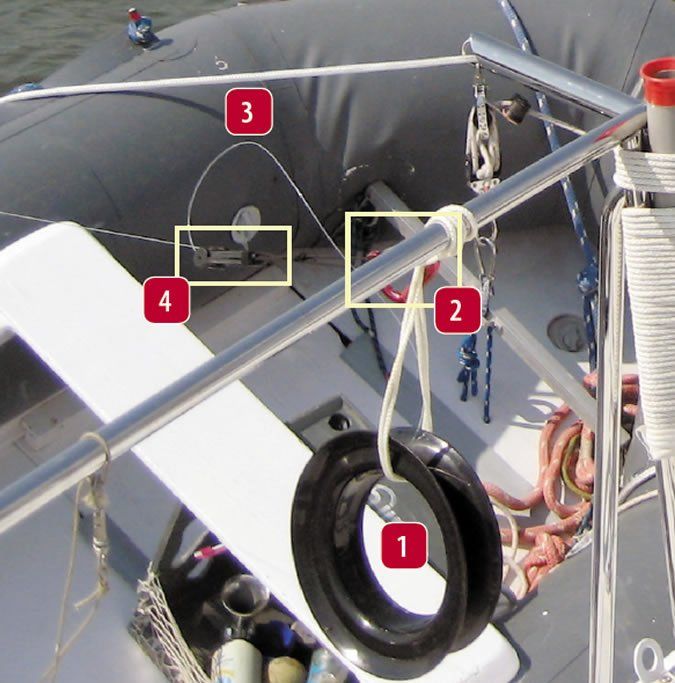
The low-cost, space-saving yo-yo hand reel is the most basic, efficient fishing gear you can find-its essentially a handline modernized with a molded plastic reel wrapped with monofilament.
Every cruising boat should carry at least one fishing rod and reel for fooling around and catching dinner, but carrying a proper trolling rig can create a storage problem on board. Enter the simple yo-yo: Pre-rigged for trolling, it is a compact, cost-effective, and efficient tool for the cruising sailor; a whole stack takes up less room than a typical tacklebox. The wide, deep spool allows for the line, inline sinker, leader, and lure to be stowed, ready for use, right on the yo-yo.
The 6-inch-inside-diameter yo-yo is best for handlining and typically comes pre-loaded with 300 feet of 40-pound test monofilament, a 1-ounce sinker, and a hook; the 8-inch yo-yo is typically sold empty and is better suited to a trolling setup.
Rigging the Yo-Yo
A broad ridge on the inside of the yo-yo allows a good grip for playing and landing any fish you can manage with one hand. (For most, however, a rod and reel is still easier to use; casting is simpler, its easier to feel the bite, and playing the fish is more dependable.)
To set up a yo-yo, secure 150 to 200 feet of 80- to 100-pound test line to the spool with a mono knot such as a clinch knot. If youre fishing for mid-depth gamefish, add a 2- to 8-ounce inline sinker with a swivel; vary the weight when youre trolling multiple rigs at the same time. Follow that with a 20-foot leader of 80- to 100-pound test and a lure of your choice. Local knowledge rules, but yellow hose eels, large Rapala trolling plugs, high-speed chrome spoons, and parachute jigs with soft baits are all popular, depending on the target fish. Size the lures according to what you can actually catch and eat.
Attach the yo-yo to the stern rail with a sling of one-eighth-inch double-braid and a carabiner. Make a small loop in the monofilament about 2 feet from the yo-yo, and place it in the flatline clip or outrigger clip (this creates a cleaner release than clipping straight line), removing the tension from the yo-yo and allowing it to hang down; when a fish bites, the clip releases, the yo-yo lifts up and back as it pulls taut against the tether, striking the stern rail and sounding the fish-on alarm.
Trolling speeds vary from 3 to 4 knots to 4 to 7 knots. For pelagic fish such as tuna and mahi-mahi, skip the weights, switch to feather jigs and kona clones, vary the line lengths, and troll at 6 to 10 knots. Though you can certainly troll with the engine on, we seem luckier under sail-or perhaps we just don’t care as much when we strike out.
To land the fish, slow down but do not stop; maintaining a minimum of 3 knots keeps the slack out of the line, preventing the fish from throwing the hook. It also helps reduce tangles by keeping everything straight. To reel in, simply wind the line back on the spool with a figure-8 motion of the arm and wrist, just as you would wind in a kite. The reel does the work and you should only touch the line to guide it and to feel the fish. If you hope to fight a large fish-and these can mange some big fish-donning sailing gloves may be a good idea.
Aboard our PDQ 32 catamaran, the typical trolling setup includes four yo-yos-two about 3 feet in from each stern corner, and two on stubby outriggers. When casually trolling, we often set just two on the corners.
To use the yo-yo, simply bait up and lower the line over the stern. If youre fishing from the beach or a tender, you can cast by letting out about 3 feet of line, then pinching the line against the yo-yos side with your thumb, and whirling the bait and sinker over your head like a slingshot. Face the low edge of the spool in the direction of the cast, and the line will whirl off, just as it does on an open-faced spinning reel.
Yo-Yo Products
For the average sailor, any Cuban-style yo-yo will likely suffice (just look for a good finger ridge and smooth molding), but we like the Challenge-brand plastic hand reels ($4, www.amazon.com). The larger size is better suited to 80- to 100-pound monofilament and has room to store an attached sinker and lure.
We also prefer Cannons Unistacker downrigger release clip. Weve tried many brands, and they all work fine, but we Recommend Cannon (www.cannondownriggers.com) as weve found them to be very reliable, easily adjustable, and the best value ($15/set of two).
For outrigger release clips, we Recommend the Tigress brand. These allow the trolling line to release from the outrigger, indicating a hit. The Tigress clips ($25 for a pair, www.westmarine.com) are reliable and a good value.
Bottom line: A lot of fun for little bitty money, yo-yos are compact enough for day sailors, yet durable enough for world sailors. For the casual angler, stick with the 6-inch diameter sizes. We Recommend Canon, Tigress, and Challenge gear for setting up your yo-yo rig.







































